
Entwining Science and Music - Concert 1
- Dr Helen Thomas (School of the Arts)
- Suitable for: All welcome
- Admission: Free
- Book now
Add this event to my calendar
Click on "Create a calendar file" and your browser will download a .ics file for this event.
Microsoft Outlook: Download the file, double-click it to open it in Outlook, then click on "Save & Close" to save it to your calendar. If that doesn't work go into Outlook, click on the File tab, then on Open & Export, then Open Calendar. Select your .ics file then click on "Save & Close".
Google Calendar: download the file, then go into your calendar. On the left where it says "Other calendars" click on the arrow icon and then click on Import calendar. Click on Browse and select the .ics file, then click on Import.
Apple Calendar: The file may open automatically with an option to save it to your calendar. If not, download the file, then you can either drag it to Calendar or import the file by going to File >Import > Import and choosing the .ics file.
Entwining Science and Music - Concert 1
Appleby/Bearon Uptake 3’36”
Gutierrez/Brust Liquid Gold 5D106S1 7’51”
Join here:
https://liverpool-ac-uk.zoom.us/j/99474217473?pwd=V0dNZldobjhpUWRzaE1EWVRJWDIxZz09
Passcode: 4jFcH=.L
Uptake (3’36”)
Composer: Anna Appleby, RNCM
Scientist: Professor Rachel Bearon, Professor of Mathematical Biology, The University of Liverpool
‘Uptake’ is based on a publication Multiscale modelling of drug transport and metabolism in liver spheroids (Leedale et al., 2020). New drugs are tested for toxic side effects in the laboratory using isolated cells. Rachel and Anna met several times in Liverpool and discussed which parts of the paper would be most applicable to music and most engaging for an audience.
At first they considered reflecting the ‘levels of reality’ aspect of the research, where mathematical modelling leads to in silico simulations (computer modelling), then to in vitro simulations (injecting a drug into spheroids which are spherical clusters of cells), and finally to clinical trials in people. Something seemingly removed from emotional context (mathematical modelling) can lead to a patient’s life being saved.
This ‘levels of reality’ aspect seemed quite difficult to translate into a 5-minute piece of music so Anna and Professor Bearon moved on to exploring how each of the figures or diagrams in the paper could be the subject of a musical miniature. A scientific poster presentation often focuses on diagrams as they are the visual, and often most succinct or accessible, element of the research, and so it made sense to use these for the piece of music. The result is a piece made of three miniatures that are inspired by three figures from the paper.
Further information at https://www.rncm.ac.uk/research/research-centres-rncm/prism/prism-blog/prism-8-cubed/uptake/
Liquid Gold 5D106S1 (7’51”)
Composer: Isabel Benito Gutiérrez, RNCM
Scientist: Professor Mathias Brust, Professor of Chemistry, The University of Liverpool
5D106S1 is a piece based on the research of the chemist Mathias Brust. His research focuses on the reaction of liquid gold (HAuCl3) with other substances, in this case tri-sodium citrate. Isabel wanted to reflect the change of colours that occurs, as the reaction takes place, in sound. First, a sudden change from pale yellow (from the gold) to black (when adding the tri-sodium citrate), then to a dark red.
The piece is divided in four sections responding to different actions and reactions of the experiment. These sections are repeated until the next stage of the process is effective. In this way, the musicians are conducted by the reaction.
Further information at https://www.rncm.ac.uk/research/research-centres-rncm/prism/prism-blog/prism-8-cubed/liquid-gold/
